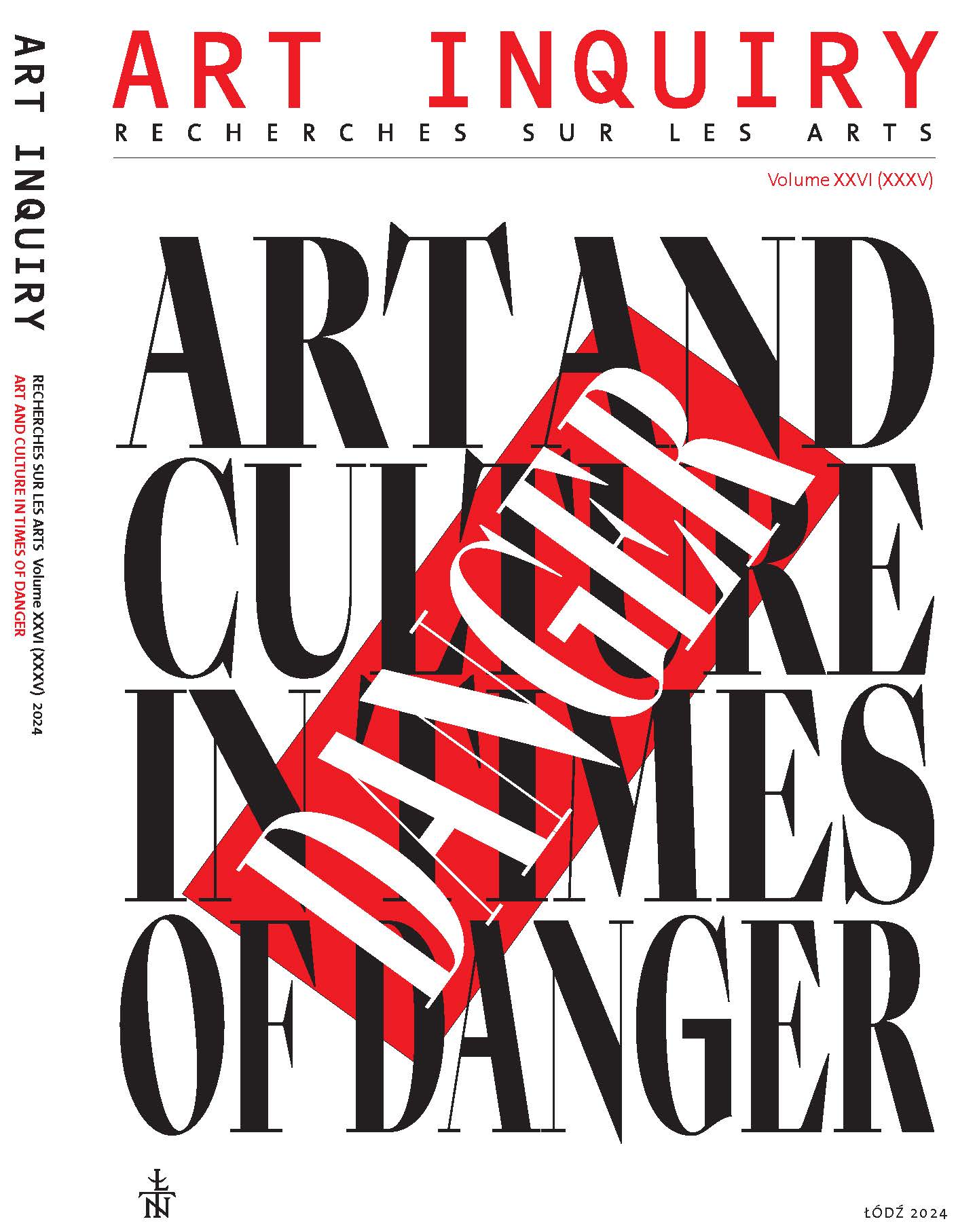Sztuka sensoryczna
DOI:
https://doi.org/10.26485/AI/2024/26/2Słowa kluczowe:
sensorium, aesthetics experience, interactive technology, responsivity, mediaAbstrakt
Celem artykułu jest przeanalizowanie właściwości sztuki, która pozwala określić rodzajowość prac artystycznych, jako sensorycznie oddziałujących podczas doświadczenia estetycznego. Oddziaływanie takie dotyczy osoby odbiorczej, która podlega wpływowi sztuki ujawniającej swój podmiotowy charakter lub będącej źródłem dla sensorycznej komunikacji pomiędzy osobami odbiorczymi. Uwzględniono znaczenie interaktywności będącej podstawą responsywności oraz zaproponowano trzy rodzaje oddziaływania sztuki, które charakteryzują taki rodzaj doświadczenia estetycznego.
Bibliografia
Aristotle (1922) Poetics [in:] 'The Poetics of Aristotle', S. H. Butcher (ed.), Fourth edition, Mac-Millan and Co., Limited, London: https://ia800901.us.archive.org/8/items/poeticsofaristot00arisuoft/poeticsofaristot00arisuoft.pdf [accessed: 23.06.2024].
Ascott Roy (2003) Telematic Embrace: Visionary Theories of Art, Technology and Consciousness, University of California Press.
Bryant Ross (2013) Dezeen, London, New York, Shanghai: https://www.dezeen.com/213/11/20/intervie w - with-human-cyborg-neil-harbisson/ [accessed: 23.06.2024].
Erkut Cumhur (2000) Abstraction Mechanisms in Computer Art, Research Gate: https://www.researchgate.net/publication/228763696_Abstraction_Mechanisms_in_Computer_Art [accessed: 23.06.2024].
Grau Oliver (2003) Virtual Art: From Illusion to Immersion, The MIT Press, Cambridge MALondon 2003.
Hupont Torres, Isabell et al., (2023) Next Generation Virtual Worlds: Societal, Technological, Economic and Policy Challenges for the EU, Luxembourg: Publications Office of the European Union: https://publications.jrc.ec.europa.eu/repoitory/handle/JRC133757 [accessed: 23.06.2024].
Ishibashi Naoki et al., (2024) Art Sensorium Project: A System Architecture of Unified Art Collections for Virtual Art Experiences [in:] M. Tropmann-Frick et al. (eds.) Modelling and Knowledge Bases, Vol. 380, IOS Press Ebooks XXXV, pp. 145-154: https://ebooks.iospress.nl/volume/information-modelling-and-knowledge-bases-xxxv [accessed: 23.06.2024].
Jones Caroline (ed.) (2006) Sensorium. Embodied Experience, Technology, and Contemporary Art, The MIT Press Cambridge MA-London.
Kluszczyński Ryszard et al. (2014) Figures of Speech, Łaźnia Centre for Contemporary Art, Gdańsk.
Krueger Myron (1991) Artificial Reality II, Addison-Wesley Publishing Company Inc., Reading MA.
Kurzweil Ray (2000) The Age of Spiritual Machines: When Computers Exceed Human Intelligence, Penguin Books, New York.
Leopoldseder Hannes et al., (2020) CyberArts 2020 – Prix Ars Electronica, Hatje Cantz Verlag GmbH, Berlin: https://ars.electronica.art/keplersgardens/files/2020/09/cyberarts2020.pdf [accessed: 23.06.2024].
McLuhan Marshall (1994) Understanding Media The extensions of man, The MIT Press, Cambridge MA-London.
Pérez Florencia Hidalgo (2020) El argentino que une el arte, la ciencia y la tecnología, La Tercera: https://www.latercera.com/que-pasa/noticia/el-argentino-que-une-el-arte-la-ciencia-y-la-tecnologia/977939/ [accessed: 23.06.2024].
Ryan Maria-Laura (2001) Narrative as Virtual Reality. Immersion and Interactivity in Literature and Electronic Media, The John Hopkins University Press, Baltimore-London.
Sætra Henrik Skaug (2022) Loving robots changing love: Towards a practical deficiency-love, “Journal of Future Robot Life”, IOS Press, Amsterdam, vol. 3, no. 2, pp. 109-127: https://content.iospress.com/articles/journal-of-future-robot-life/frl200023 [accessed: 23.06.2024].
Stocker Gerfried, Jandl Markus (2022) Ars Electronica 2022, Festival for Art, Technology, and Society– Welcome to Planet B. A different life is possible. But how, Hatje Cantz Verlag, Berlin: https://ars.electronica.art/planetb/en/download/ [accessed: 23.06.2024].
Walewska Joanna (2009) Relationship of art and technology: Edward Ihnatowicz's philosophical investigation on the problem of perception [in:] S. Cubitt, P. Thomas (eds.), Re: Live Media Art. Histories 2009, Melbourne: The University of Melbourne & Victorian College of the Arts and Music, pp. 172-177: Phttps://www.mat.ucsb.edu/ublications/burbano_MAH2009.pdf [accessed: 23.06.2024].
Feingold Ken: http://www.kenfeingold.com [accessed: 23.06.2024].
Fock Mikael (Artificial Mind), SH4D0W An AI Performance in 3D: https://www.artificialmind.ai/projects/sh4dow [accessed: 23.06.2024].
Hentschläger Kurt: https://kurthentschlager.com [accessed: 23.06.2024].
Kaegi Stefan (Rimini Protokoll), Uncanny Valley: https://www.rimini-protokoll.de/website/en/project/unheimliches-tal-uncanny-valley [accessed: 23.06.2024].
Ishiguro Hiroshi, Kyoto experiment: https://www.youtube.com/watch?v=CWnnqObk1qM [accessed: 23.06.2024].
Moon Ribas: https://www.cyborgarts.com/moon-ribas [accessed: 23.06.2024].
Radlak Aleksandra, Bo.by: https://aleksandraradlak.wixsite.com/portfolio/boby [accessed: 23.06.2024].
Rokeby David, International Feel: http://www.davidrokeby.com/int_feel.html [accessed: 23.06.2024].
Yamauchi Shota, (Ars Electronica) Maihime: https://ars.electronica.art/planetb/en/maihime/ [accessed: 23.06.2024].
Sermon Paul: http://www.paulsermon.org [accessed: 23.06.2024].
Yoshifuji Ory, (Ory Lab), Avatar Robot Café DAWN ver.ß: https://dawn2021.orylab.com/en/ [accessed: 23.06.2024].
Pobrania
Opublikowane
Numer
Dział
Licencja
Prawa autorskie (c) 2024 Łódzkie Towarzystwo Naukowe

Utwór dostępny jest na licencji Creative Commons Uznanie autorstwa 4.0 Międzynarodowe.



